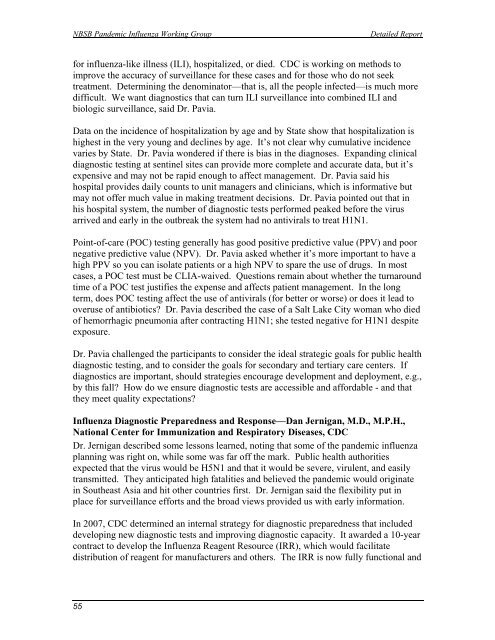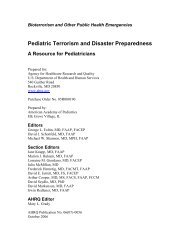H1N1 COUNTERMEASURES STRATEGY AND ... - PHE Home
H1N1 COUNTERMEASURES STRATEGY AND ... - PHE Home
H1N1 COUNTERMEASURES STRATEGY AND ... - PHE Home
You also want an ePaper? Increase the reach of your titles
YUMPU automatically turns print PDFs into web optimized ePapers that Google loves.
NBSB Pandemic Influenza Working Group<br />
Detailed Report<br />
for influenza-like illness (ILI), hospitalized, or died. CDC is working on methods to<br />
improve the accuracy of surveillance for these cases and for those who do not seek<br />
treatment. Determining the denominator—that is, all the people infected—is much more<br />
difficult. We want diagnostics that can turn ILI surveillance into combined ILI and<br />
biologic surveillance, said Dr. Pavia.<br />
Data on the incidence of hospitalization by age and by State show that hospitalization is<br />
highest in the very young and declines by age. It’s not clear why cumulative incidence<br />
varies by State. Dr. Pavia wondered if there is bias in the diagnoses. Expanding clinical<br />
diagnostic testing at sentinel sites can provide more complete and accurate data, but it’s<br />
expensive and may not be rapid enough to affect management. Dr. Pavia said his<br />
hospital provides daily counts to unit managers and clinicians, which is informative but<br />
may not offer much value in making treatment decisions. Dr. Pavia pointed out that in<br />
his hospital system, the number of diagnostic tests performed peaked before the virus<br />
arrived and early in the outbreak the system had no antivirals to treat <strong>H1N1</strong>.<br />
Point-of-care (POC) testing generally has good positive predictive value (PPV) and poor<br />
negative predictive value (NPV). Dr. Pavia asked whether it’s more important to have a<br />
high PPV so you can isolate patients or a high NPV to spare the use of drugs. In most<br />
cases, a POC test must be CLIA-waived. Questions remain about whether the turnaround<br />
time of a POC test justifies the expense and affects patient management. In the long<br />
term, does POC testing affect the use of antivirals (for better or worse) or does it lead to<br />
overuse of antibiotics? Dr. Pavia described the case of a Salt Lake City woman who died<br />
of hemorrhagic pneumonia after contracting <strong>H1N1</strong>; she tested negative for <strong>H1N1</strong> despite<br />
exposure.<br />
Dr. Pavia challenged the participants to consider the ideal strategic goals for public health<br />
diagnostic testing, and to consider the goals for secondary and tertiary care centers. If<br />
diagnostics are important, should strategies encourage development and deployment, e.g.,<br />
by this fall? How do we ensure diagnostic tests are accessible and affordable - and that<br />
they meet quality expectations?<br />
Influenza Diagnostic Preparedness and Response—Dan Jernigan, M.D., M.P.H.,<br />
National Center for Immunization and Respiratory Diseases, CDC<br />
Dr. Jernigan described some lessons learned, noting that some of the pandemic influenza<br />
planning was right on, while some was far off the mark. Public health authorities<br />
expected that the virus would be H5N1 and that it would be severe, virulent, and easily<br />
transmitted. They anticipated high fatalities and believed the pandemic would originate<br />
in Southeast Asia and hit other countries first. Dr. Jernigan said the flexibility put in<br />
place for surveillance efforts and the broad views provided us with early information.<br />
In 2007, CDC determined an internal strategy for diagnostic preparedness that included<br />
developing new diagnostic tests and improving diagnostic capacity. It awarded a 10-year<br />
contract to develop the Influenza Reagent Resource (IRR), which would facilitate<br />
distribution of reagent for manufacturers and others. The IRR is now fully functional and<br />
55
















